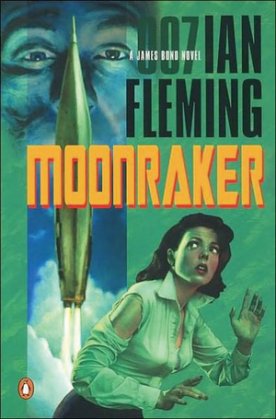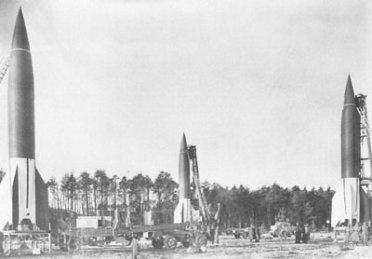|
The Man Who Was Only A Silhouette - Ian Fleming's Moonraker

Moonraker was the third James Bond novel in the series of books written
by the great Ian Fleming and originally published in 1955. The story
revolves around a mysterious tycoon called Sir Hugo Drax. Drax, in a
move regarded as an altruistic gesture to the British Government, is
the driving force behind a nuclear missile project called 'Moonraker'
which he is developing in Kent near the coast. The revolutionary
missile contains top secret elements that only Drax controls. It will
safeguard the security of Britain in the unstable and uncertain era of
the cold war.
When M, the head of the British Secret Service - MI6 - discovers that
Drax may be cheating at Bridge, in M's club Blades of all places, he
asks James Bond to go and confirm or deny his suspicions by gambling
with Drax. Bond lays a trap and discovers that Drax is indeed cheating.
But why? He's a millionaire building a top secret weapon for the
Government. Can he be trusted? When a Government official assigned to
Drax's Moonraker project is killed, M decides that James Bond must
travel to the Kent coast and unravel the mystery of Hugo Drax once and
for all...
Moonraker is a Bond novel I've always had a soft spot for. It's
slightly underrated perhaps because of the more fantastical nature of
the plot with missile malarkey and a big revelation. This is James Bond
in the rocket age. A considerable portion of the first half of the book
does contain though one of Fleming's most famous and effortless set
pieces that is low key but very absorbing. At M's club, Bond pits his
wits agaisnt Drax at the gaming tables.
007's novel preparation for his evening of Bridge with Drax is very unique and Fleming.
'Benzedrine,' said James Bond.
'It's what I shall need if I'm going to keep my wits about me tonight.
It's apt to make one a bit overconfident, but that'll help too.' He
stirred the champagne so that the white powder whirled among the
bubbles. Then he drank the mixture down with one long swallow. 'It
doesn't taste,' said Bond, 'and the champagne is quite excellent
Fleming's attention to detail, style, love of colour, gambling, food
(You will be reaching for the Gaviscon reading Moonraker), and the
high-life adds a considerable amount of atmosphere and interest to a
scene that is fairly uneventful on the face of it. Fleming loved to
create colourful villains who play cat and mouse with Bond in refined
surroundings before the nefarious masterplan is revealed and Drax is a
good example of this trait.
Another nice thing about Moonraker is how the M - Bond relationship is
fleshed out. At the start Bond is investigating Drax as a favour for
his boss. A sort of after hours casual assignment;
"M lifted his yes from his pipe
and cleared his throat. 'Got anything particular on at the moment,
James?' he asked in a neutral voice. 'James.' That was unusual. It was
rare for M to use a Christian name in this room."
The mutual respect and fondness these two characters feel for each
other, despite their sometimes edgy relationship, is pleasantly
illustrated in little moments like this.
Bond himself is drawn in a bit more in Moonraker. We get more of a
flavour of his day to day life. These nuggets are fascinating for Bond
fans. His office, target practice on the shooting range. His Bentley.
And of course we meet his beloved Scottish housekeeper and get an
insight in his home life. Bond has a comfortable flat on the King's
Road and we learn that he likes to spend money because he wants to
leave nothing when he dies. Double-O agents had to retire at 45 but
Bond did not expect to reach that age in his profession. He expected to
be killed on a mission any day. We also learn that Bond is 37 and earns
£1,500 a year.
One of the interesting things about the book is that it is set in
Britain, and principally Kent. Some readers prefer to see Bond in some
far flung location and find this a drawback to the book. For me the
locations of Moonraker are a big part of the charm. I enjoyed Bond's
drive from London to Dover a great deal. Fleming describes the
backdrops and little scenes with his usual attention to detail.

Moonraker picks up the pace when Bond travels to Romney Marsh to
investigate the Moonraker Project and more specifically Drax. He meets
Gala Brand there. Brand is undercover investigating Drax for Scotland
Yard and she teams up with Bond to unravel the secret of the Moonraker
project. Brand is not the best female Fleming ever wrote but she's
pretty interesting and plays a big part in the story. In a way Brand is
unique amongst Bond girls but I won't spoil the story by revealing why.
She has a susprising moment in Moonraker.
There is some good cloak and dagger stuff in the final parts of the
book with car crashes and punch-ups. Fleming also injects his usual
quota of sadism into Moonraker with a few passages that will have the
reader wincing, including a brutal interrogation scene.
The author has great fun writing about missiles and rockets and secret
defence projects. The notion of Britain developing a super missile that
was beyond anything the Soviets had must have appealed to him a great
deal. The fact that the book was written in the fifties adds to the
retro charm.
Overall, Moonraker is an entertaining and typically stylish addition to
the literary Bond adventures written by Fleming. The author is
gloriously in his element during the Blades Club sections and also
clearly enjoyed painting a portrait of locations closer to home than
usual. It gives the reader a sense of Bond's country and patriotism. Of
what Bond is ultimately there to safeguard.
The real charm of course is in entering the refined, heightened world
of Fleming's imagination through a hero who lives each day as if it
might be his last. Bond is dashing, brave, tough, suave, sometimes
depressed, but a man who lives the high life. He eats the best food,
drinks vintage labels, and cops off with women who you'd never meet in
real life.
He's just a fun, interesting and cool character and his adventures remain a wonderful escapist refuge.
- Jake
c
2008
Alternative 007
|

|


